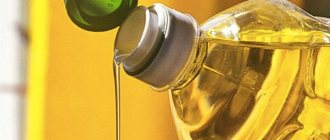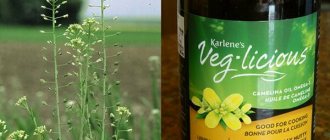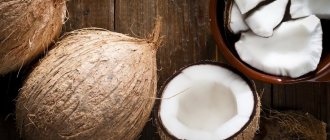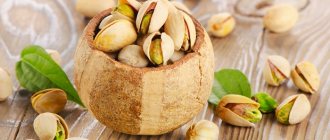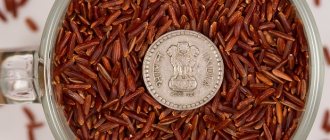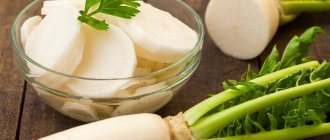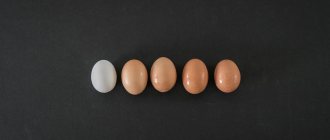Camelina oil was very popular at one time, but over time it was replaced by sunflower oil. However, it is still used today. And although it is not so common, nevertheless, the product has a large number of useful properties. The oil is used both in cooking and in medicine and cosmetology. Let's look at what it is and how to use it.
Beneficial properties for the body
Before you start taking camelina oil, you need to find out what it is made from, when it brings benefits and harm.
Compound
The composition of camelina oil includes:
- fatty acid;
- minerals - magnesium in the highest concentration, phosphorus, calcium, potassium are also present;
- vitamins E, K;
- phospholipids;
- plant sterols;
- chlorophyll.
Fatty acids are present in the optimal ratio: Omega-3 – 37%, Omega-6 – 17%. People experience a shortage of the former and an excess of the latter.
Previously, the oil contained monounsaturated erucic acid. It is toxic to the heart muscle. Over time, breeders developed non-eruce varieties of camelina, which are not dangerous.
What is it made of?
People unfamiliar with this product are wondering what camelina oil is made from. It does not belong to the mushrooms of the same name. The product is made from the seeds of spring camelina, or sowing. It grows near roads and in lowlands; it is planted for industrial purposes in Siberia and the Volga region. Belongs to the cruciferous family. The plant was named this way for the yellow-red color of the seeds. Popularly known as rape.
This is what the plant looks like from the seeds of which camelina oil is made
To answer the question of what camelina oil is, you should consider the technologies for its production:
- cold - the raw materials are pressed, and the oil yield is 18-20%;
- hot - to reduce production costs, the seeds are heated to 100-120°C and pressed again, obtaining another 5-7% of the product.
The beneficial properties and contraindications of camelina oil depend on the production method. Cold pressed product contains more vitamins and minerals. It is used for health purposes. It has a pungent taste and characteristic aroma.
Hot pressed oil loses valuable elements under the influence of temperature. It is refined to remove toxic impurities. It acquires a neutral taste and greenish color.
For medicinal purposes, unrefined camelina oil is purchased: it brings benefits, not harm. Should rapeseed oil be included in the diet? Unrefined sunflower oil.
Benefits for women and men
The benefits of camelina oil for the body are explained by the presence of various chemical elements.
The product strengthens the immune system, increases overall resistance, and fills with energy. But a lasting effect is observed only with constant use. Benefits of camelina oil:
- magnesium improves the metabolism of proteins and carbohydrates, normalizes the amount of sugar in the circulatory system, strengthens the heart and blood vessels, and in combination with vitamins K prevents bone fragility;
- antioxidant compounds protect the body from the harmful effects of free radicals and have an anti-cancer effect;
- fatty acids have high energy value;
- phospholipids have a beneficial effect on the condition of the liver: they regulate the synthesis and secretion of bile, prevent the occurrence of diseases;
- plant sterols have a positive effect on metabolic processes and the functioning of the endocrine system.
Camelina oil does not have any special properties that make it recommended for men. The popular belief that it treats prostatitis does not correspond to the actual composition: there is no ingredient in the oil that could have such an effect. However, for prostate adenoma, the product can be recommended as containing phytoestrogens that have antiandrogenic activity. Pumpkin seeds for prostatitis.
Calorie content
The calorie content of camelina oil is 897 kcal per 100 g. One teaspoon (5.5 g) contains 49 kcal, a tablespoon (17 g) - 153 kcal, a glass (190 g) - 1704 kcal. 99.8% of the total mass is fat. There are almost no proteins and carbohydrates.
Features of the production process
Camelina sativa seeds contain about 40% oil, which is extracted by pressing. The first pressing is cold, allowing maximum preservation of nutrients and obtaining a beautiful golden-yellow hue. A hot pressing procedure is then applied to obtain a residual oil with a yellowish-brown color. The product is subjected to refining and deodorization, left to settle in food-grade metal containers, and then bottled into glass or plastic bottles.
Due to the manufacturing features, unrefined camelina oil is highly resistant to oxidation - it contains many natural antioxidants. But after refining and deodorization, the product loses most of the beneficial substances that enhanced the antioxidant capacity of vitamin E, therefore oxidation resistance and, consequently, shelf life decreases.
How to use?
In order for camelina oil to bring benefits and not harm, you should learn how to take it.
Since the product is not a medicine and is 100% fat, it cannot be consumed in its pure form isolated from food.
For general strengthening purposes, take it every day. It is important to follow the daily dosage and take regular breaks.
Here are 2 basic rules for taking camelina oil:
- with food - adding 1 tbsp. l. in a portion of salad, in side dishes;
- Duration of treatment – 3 months.
For children under 10 years of age, the dosage is reduced to 1 tsp. It is not recommended to give the product to children under 3 years of age.
Are there any contraindications for use?
There are a minimum of contraindications to the use of such a valuable natural product: it should not be used by people with individual intolerance to the components and by patients with the acute stage of cholecystitis or pancreatitis. High calorie content excludes consumption by obese patients. In recommended doses, camelina oil does not put stress on internal organs and does not cause harm or side effects. But care should be taken in treatment in the presence of chronic diseases. It is not recommended to replace other vegetable fats with it and exceed the daily dose, so as not to upset the balance of linolenic acid, which should not enter the human body more than linoleic acid.
Review Reviews
Buyers leave positive reviews about camelina oil. They liked that it was suitable for frying (refined) and was healthy. Women emphasized its cosmetic effect:
- increasing skin elasticity;
- relieving irritation and redness;
- deep hydration;
- strengthens hair and makes it smooth.
Not everyone appreciated the unique taste and aroma. In some regions the product may be difficult to find on sale. But consumers did not find any serious shortcomings. Can you fry in olive oil?
How to choose and store correctly
High-quality refined camelina oil is light yellow in color, with a delicate taste and not a pronounced odor. After deodorizing and refining, the purified product is stored for 3-6 months. Unrefined camelina oil has an islandy-bitter taste and rich aroma. The product, obtained by cold pressing, has a dark golden hue. Nutrients last up to 12 months.
When storing a tightly closed bottle, the temperature should be maintained at no more than 15o C. Can be stored in the refrigerator and always in a dark container. When purchasing, you need to pay attention to the release date and the integrity of the packaging - after the first opening, the product begins to lose its properties.
Application in cosmetology
People use camelina oil in cosmetology: it enhances the body's ability to regenerate, rejuvenates and restores skin and hair. Treatments are easy to make at home.
For hair
Regular use of camelina oil for hair:
- improves appearance;
- returns natural shine and smoothness;
- prevents section;
- reduces sebum production.
It does not weigh down the curls. It is used alone or in combination with other cosmetics.
The product stops hair loss by rubbing camelina oil into the hair and leaving it for a couple of hours. It enriches the hair with valuable elements due to its ability to penetrate the hair structure. Antimicrobial properties help fight dandruff.
For face
Transdermality (the ability to penetrate the skin structure) explains the effectiveness of using camelina oil for the face. It:
- relieves inflammation;
- heals acne marks;
- evens out tone;
- nourishes the deep layers of the skin;
- eliminates dryness.
Women use camelina oil for their face against wrinkles. It contains vitamin E, which has earned the title of the source of youth and beauty. This substance restores the skin, gives elasticity, eliminates dehydration and signs of aging.
For skin
When using camelina oil on the skin, wound scarring goes away faster. To speed up the healing of scratches and cuts, compresses are made from it. The oil is applied to a clean cloth and applied to the damaged area for one hour.
When used externally, they reduce the manifestations of:
- eczema;
- psoriasis;
- neurodermatitis;
- hives.
The product relieves diaper rash. It is suitable even for the delicate skin of a baby. To obtain the desired effect, rub it 2-3 times a day into the problem area.
Camelina oil in cooking
The product made from camelina oil is recommended to be taken in the diet to obtain essential vitamins and aromatic flavor.
Why did chefs love the product? Unrefined butter has a pungent flavor and an unusual aroma. Reviews say that the product tastes like horseradish and radish. Because of this property, it is used as a dressing for salads and cold appetizers.
Where else is a herbal remedy used in cooking? It is included in the following recipes:
- cereal porridge;
- baking;
- Dessert;
- goulash.
It is not forbidden to use camelina oil for frying, but as the temperature increases, all the beneficial elements in its composition are destroyed.
Reviews indicate that if you fry a vegetable product made from camelina, the taste is not lost. In this case, the benefit from use will be low. Conclusion – you shouldn’t fry with camelina oil.
Recipes
"Strawberry dessert"
For preparation you will need the following ingredients:
- Half a glass of milk;
- Two bananas;
- Half a glass of fresh orange juice;
- Half a teaspoon of vanilla;
- Three quarters of small yogurt;
- Two spoons of honey product;
- Three tablespoons of camelina oil;
- Two glasses of strawberries.
Mix milk and bananas in a blender. Then other ingredients are added, and at the very end, strawberries are added to the blender. The dessert is served chilled.
Broccoli salad
For the salad you will need two medium cups of fresh pineapple pieces, the same amount of broccoli, a glass of cherry tomatoes, one tablespoon of sesame seeds (pre-roasted). Everything is added to the container, then the dressing is prepared. To do this, whisk two tablespoons of honey, two small spoons of ginger, one-fourth cup of camelina oil, two tablespoons of water and one and a half tablespoons of lemon juice. Mix everything and sprinkle sesame seeds on top.
Recipes can be found on specialized websites. There are recipes with minimal ingredients. For example, it is recommended to season potatoes with camelina oil.
Is it effective for losing weight?
When using camelina oil for weight loss, the kilograms will not go away. The product is 100% fat with a high calorie content, and, as is known, in order to lose weight, the energy value of what is consumed must, on the contrary, decrease.
To lose weight naturally, you need to eat more low-calorie vegetables and maintain an adequate level of physical activity. Camelina oil does not help you lose weight. Chia and flax seeds for weight loss.
What does it contain?
Camelina oil is an energy-valuable food product with a fairly high calorie content (Table 1). Glycemic index is 0.
Table 1. Calorie content and composition
| Name | Content per 100 g | Unit change |
| Squirrels | 0.02 | G |
| Fats | 99.7 | G |
| Carbohydrates | 5.7 | G |
| Energy value | 901 | kcal |
The advantage of camelina oil is the content of high concentrations of unsaturated fatty acids and their optimal proportion with the amount of saturated fatty acids (Table 2). Linolenic (omega-3) and linoleic acids (omega-6) strengthen the walls of blood vessels, normalize fat metabolism, reduce the risk of stroke and heart attack, and lower cholesterol levels.
Table 2. Nutrient balance
| Substance name | Content per 100 g |
| Vitamin E | 120 mg |
| Vitamin A | 2 mg |
| Gamma tocopherol | 756 mg |
| Alpha-linoleic acid | 45 g |
| Alpha tocopherol | 30 mg |
| Linoleic acid | 22 mg |
| Delta tocopherol | 21 mg |
| Eicosenoic acid | 20 mg |
| Oleic acid | 18 g |
| Solanochromene | 16 mg |
| Palmitic acid | 8 g |
The composition contains more magnesium than other vegetable oils, and in terms of beta-carotene content, camelina oil is ahead of sunflower and soybean oil. One tablespoon of the product contains the daily requirement of vitamin E. There are also vitamins A, D, K, F, K; minerals: calcium, phosphorus, potassium; phospholipids, phytosterols, chlorophyll, etc.
Can it be used during pregnancy?
Camelina oil during pregnancy is valued for its high concentration of fatty acids. They have a positive effect on the condition of the woman and the fetus:
- prevent premature birth and placental deficiency;
- give energy;
- stabilize the emotional state;
- contribute to the proper formation of the nervous, endocrine, immune systems and brain of the child.
Taking oil during lactation reduces the chances of developing allergies and diathesis in the baby.
To avoid negative consequences, it is better to consult a specialist before starting use.
Harm and contraindications
Harm and contraindications to the use of camelina seed oil are minimal, since the product is 100% natural.
Allergic reactions and individual intolerance are possible. In addition, camelina oil may be contraindicated:
- Pregnant women should consult a doctor before using the product.
- If you are obese, it is undesirable to abuse the product due to the high calorie content and fat content in the oil. Use only with the permission of a doctor.
- For pancreatitis, especially during exacerbation of the disease.
In any case, the main thing is not to overuse products. Try it in a minimal amount the first time to make sure you are not intolerant to the specific flavored oil.
© PHILETDOM — stock.adobe.com
Recipes for healthy eating
Baked pears in the oven
- 0.5 g Protein
- 0.4 g Fat
- 11.5 g Carbohydrates
- 46 kcal
30 min.
- #vegetarian dish
- #pears
- #dessert
- #dietary
- #breakfast
- #raisin
- #yogurt
- #honey
- #low calorie
- #oatmeal
- #snack
- #granulated sugar
- #butter
Other recipes
Kinds
Depending on the production technology, refined and unrefined camelina oil are distinguished. The first type is obtained by extraction, the second - by hot pressing or cold pressing. What is the difference between these production methods?
Cold pressing is carried out on special equipment, where unrefined healthy oil is extracted from raw materials under pressure. A more aromatic product is obtained by hot pressing, followed by partial purification: filtering, neutralization, hydration. However, such unrefined oil contains fewer nutrients and proteins. It is less healthy than raw.
The essence of the extraction method is the ability of the oil to dissolve in hexane or gasoline. When mixing raw materials with these substances, the oil goes into a petrochemical solvent and undergoes further distillation. Once purified, there is no guarantee that toxic hexane has been completely removed from the product.
Distinctive features of refined camelina oil from unrefined:
- Smell. Unlike refined, unrefined retains its natural aroma and slightly spicy taste. The first is used in cooking for frying meat, fish, and baking confectionery, as it has a neutral odor. The second is used for preparing sauces, gravies, dressing boiled vegetables, salads and vinaigrettes, when the dish must retain its characteristic vegetable aroma.
Camelina oil is not recommended to be subjected to heat treatment, since under the influence of high temperatures its beneficial substances (vitamins, polyunsaturated acids) are destroyed.
- Consistency. The unrefined product is richer and fattier than the refined one.
- Shelf life. Refined pomace, sealed in bottles, placed in a dark room with an ambient temperature of 8 to 20 degrees, is good for two years. After opening the container, the shelf life is reduced to 14 days at room temperature and to 30 days if the product is stored in the refrigerator. Interestingly, in the cold the oil does not turn into ice, but only thickens. However, cold treatment does not preserve vitamins and nutrients, so freezing the unrefined product is not recommended.
After uncorking the plastic bottle, the contents are poured into a darkened glass container with a narrow neck. If unrefined camelina oil was produced by hot pressing, its shelf life is 10 months, cold pressing - no more than 4 months.
Thus, the value of vegetable oil depends on the number of processing steps. The more of them, the longer the product can be stored and the less nutrients, antioxidants and PUFAs remain in it.
Unrefined oil is healthier than refined oil.
To preserve its nutritional value and healing properties, it is stored in a dark, warm place without access to light and air. When refined camelina oil is heated again, carcinogens (aldehyde) are formed in it - toxic substances for the human body that can accumulate in tissues, negatively affect the respiratory tract, the mucous membrane of the eyes, which ultimately threatens the development of cancer.
Benefits of camelina oil
- The beneficial properties of the product include regenerating, anti-edema, and anti-inflammatory effects. Many studies have been conducted using camelina oil, during which scientists have proven the effectiveness of the composition in the fight against cancer.
- Omega acids are involved in lipid metabolism. These compounds control the adult hormonal environment and also boost the immune system. Acids strengthen blood channels, remove cholesterol and prevent atherosclerosis.
- The product does not undergo oxidation throughout the year, as a result of which it can be stored for a long time and used regularly. Oil accumulates retinol, or vitamin A, which increases all metabolic processes.
- The positive effect of the product is achieved due to its ability to improve eye health and improve vision. The raw material should be taken by people who are prone to vision loss or other diseases in this area.
- Camelina oil improves the condition of the mucous membranes, allowing small ulcers to heal. The composition eliminates bad breath, treats stomatitis and bleeding gums.
- Minerals in large quantities, namely magnesium and potassium, are necessary for the heart muscle. With the systematic intake of camelina oil, the heart rate and blood pressure are normalized, and the nervous system comes into order.
- Magnesium is needed for the treatment and prevention of allergies in adults and children. Squeezing camelina improves blood composition and accelerates its circulation. This reduces the likelihood of developing varicose veins, thrombophlebitis, and other similar ailments.
- The product is also useful for people with diabetes. The oil reduces blood glucose levels. The phospholipids included in the composition improve the condition of the liver. This quality is useful for those who are at risk of developing cirrhosis.
- Not without the beneficial effects of raw materials on the digestive tract. Camelina oil, like all its counterparts, lubricates the mucous membranes of internal organs. Against this background, constipation disappears, congestion is eliminated, food is better absorbed and does not ferment in the esophagus.
- Chlorophyll removes mucus from the respiratory tract and reduces the harmful effects of nicotine on the lungs of smokers. This compound also has a bactericidal effect, improves blood composition and increases hemoglobin. A small accumulation of iron in oil is necessary to prevent anemia.
- Phytosterols are necessary for the male half of the population to prevent diseases associated with the prostate gland. Since ancient times, vegetable oil has been used to treat impotence and stimulate reproductive activity.
Composition and content of active substances
Vegetable fat from camelina is a rich source of lecithin, minerals, vitamins, and contains up to 72% unsaturated fatty acids. Also noteworthy are niacin, an important part of the vitamin B3 complex, and inulin, which cleanses the intestines, regulates microflora, and is important for diabetics.
The most important active substances and their beneficial properties:
unsaturated fatty acids omega-3 - we are talking about their richest source, omega-3 - essential oils necessary for the proper functioning of the human body, lignans - plant chemicals with expressive anti-cancer, antibacterial, antiviral, antifungal properties (camelina seeds contain 100 times more than any other plant source), fiber - a substance important for proper bowel function, reducing the risk of colorectal cancer, vitamins - E, B1, B2, B3, B5, B6, B9, minerals - iron, zinc, calcium, phosphorus , sodium, potassium, magnesium, manganese, copper, β-carotene. Phytoestrogens
Phytoestrogens
Lignans belong to phytoestrogens and provide the positive properties of camelina vegetable oil. In addition to antioxidant effects, phytoestrogens influence the metabolism and function of the natural hormone estrogen, binding to receptors in the chest, ovaries and uterus, reducing overexpression of the female hormone.
Using oil in nail and hair care
Since camelina oil actively affects the cellular level and affects the water-lipid balance, but does not have active nourishing or strengthening properties, it is practically not used in nail care (only in massage creams or in medicinal cosmetics for the skin of the hands).
In the field of hair care, camelina oil is considered one of the most effective softening tools: it can make hair soft and manageable in just one procedure . But to manifest this talent, the oil must be used in long-term exposure methods - masks and balms.
Benefits for the stomach and digestive system
Unrefined camelina oil is rich in various nutritional components that have a positive effect on the functioning of the gastrointestinal tract. Its use stimulates appetite, protects the gastric mucosa from damage, and promotes its healing. Carboxylic acids in the composition normalize the process of food digestion, eliminate constipation, colic and bloating.
In practice, it is recommended for erosive and ulcerative pathologies; it also helps with colitis, enteritis, gastritis, and duodenitis. It can be used for both medicinal and preventive purposes. It is recommended to use 1 tablespoon 1 time per day for 28 days.
